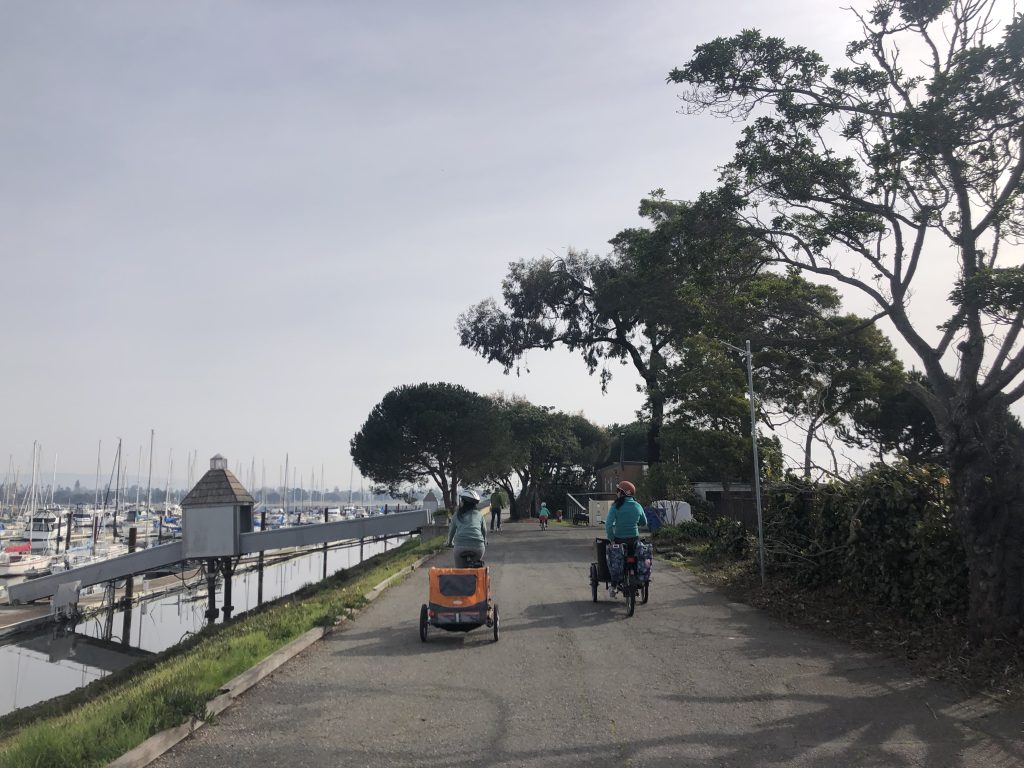My hometown is super bike-friendly; there are clear bike lanes, a city-wide speed limit of 25 miles per hour, and the weather is moderate year-round. My partner and I used to bike to nearby grocery stores or breweries, and when we had kids, we invested in a bike trailer.
It wasn’t long before my kids outgrew the space of the trailer and started to bicker, mostly about the baby pulling hair. I couldn’t see what was going on behind me or intervene in the sisterly quarrel while biking and wondered if there was a better way.

During the pandemic I started to see cargo bikes all around town, some with kids on the back, some with kids up front, all kinds of different colors and sizes, and every parent and child on the bike looked like they were having a grand old time. I was intrigued.
Could a cargo bike could be the answer to all of my problems? It seemed like the perfect solution to turn our preschool commute into a way to get exercise and for me to enjoy the outdoors with my children, reduce my carbon footprint, and still be able to get to work on time!

Our cargo bike has been that, and more. Now that I’ve been a cargo bike rider for a year, I wanted to share what I’ve learned with you, in the hopes that it might be a useful tool in your decision to join the #cargobikelife.
I talk about my cargo bike all of the time. People on the street are often asking me the same questions:
What is a cargo bike?
A cargo bike is a bike designed to carry more cargo than just the rider in the front or back of the bike. Thanks to the extra cargo space, a cargo bike can allow you to transport multiple kids, pets, adults, and, well, cargo all at the same time.
Cargo bikes usually accommodate a larger age range for their passengers, allowing you to transport babies, kids, and adults, therefore extending the life of your bike longer than a bike trailer or baby seat.

Why should you get a cargo bike for your family with little kids (0-7)?
Cargo bikes are perfect for families. They allow for multiple kids to ride together with an adult and engage with the world around them at the same time. You can have a conversation with your kids, play music, eat snacks, and keep an eye on what is going on in a way you cannot while driving. The kids are also next to each other and can engage with each other differently than they can while confined to their car seats.
The bike is great for families who are trying to reduce their carbon footprint too! We’ve hauled kids, adults, groceries, backpacks, and a dog in our cargo bike.

What are the 4 types of cargo bikes and their costs?
There are four types of cargo bikes: the longtail, the mid-tail, the long john (or bakfiets which means ‘bike box’ in Dutch), and the front-load trike.
The Longtail Cargo Bike
The longtail can fit 1-3 kids on the back deck and looks like it has an extended back bike rack. The extra cargo space is on the longer tail end of the bike and any added saddlebags under the kid’s legs or in a front basket. Popular longtail options are Xtracycle (electric e-Swoop $4,999) and the Yuba (non-electric Kombi $1199 and electric Kombi $3299).
I’ve asked some of our neighbors with longtail bikes for their review, and all love how they ride like a typical bike, and how customizable each one is. These customizable options—such as adding a baby bike seat ($200), handlebars for the back riders ($200), footrests ($120), padded seats ($70)—come with an added cost which can quickly turn your reasonably priced cargo bike into quite the expense.

The Midtail Cargo Bike
The mid-tail cargo bike has a shorter tail than the longtail and can fit 1-2 small kids or 1 bigger kid with space between the kid and the rider. The Yuba Fast Track ($3,999) is a popular example of the mid-tail electric-assist cargo bike. The shorter frame of the mid-tail makes riding and storage easier, however, the extra cargo capacity is limited.

The Long John/Bakfiets Cargo Bike
The long john/bakfiets like the Yuba Supermarché (non-electric $3,500) and Urban Arrow (electric $6,999) have a front-loading cargo box for 1-3 passengers between the handlebars and the front tire.
The one parent I met with a bakfiet loves having their kids upfront to see what they are seeing as you ride, and feels the weight balance is easy to maneuver since the cargo box sits so low to the ground. These cargo bikes come with extra features too, such as clips to attach your infant car seat or an extra seat up front to fit one additional passenger.

The Front-Load Trike Cargo Bike
The Front-Load Trike has two wheels supporting a larger box in the front of the bike and one wheel in the back under the bike seat.
This cargo bike design allows you to carry 4 children (or 2 kids and one adult) comfortably in the cargo box in front of the bike and provides ample storage.
Some popular options are the Ferla Family Cargo Bike (Inspire $2,999 non-electric; $3,999 electric), and the Bunch Bike ($5,800 + electric).

The cargo bike rotates in the middle of the cargo box rather than at the handlebars. This pivot point change makes riding this bike a little tricky (see video for an example). The bike is also designed to tilt the seat towards the inside of the turn in order to shift the biker’s weight and prevent the bike from tilting.
Once you’ve figured out the steering, riding this bike provides maximum stability for your passengers because all weight is supported on two wheels instead of one.
We decided to buy a front-load cargo trike and absolutely love it. Read here for our review of the Ferla Family Cargo Bike – Royce Edition and the Babboe Curve.
Now, to e-bike or not to e-bike? That is the question…
Do You Need An Electric-Assist Cargo Bike (E-Bike)?
An “e-bike” is a bike that has an electric assist battery attached, which adds power to each pedal. This upgrade features a throttle on the handlebars and a speedometer gauge that tells you speed and battery power level.
Pros: With an electric-assist on your bike, you can peddle uphill no matter the cargo weight. The electric-assist adds power to your pedals, allowing you to go farther for longer and faster, which might result in you using the bike more. It gives an extra push at stoplights when you need to move quickly to keep up with the flow of traffic.
Cons: Adding an electric assist is a noticeable added cost to an already expensive purchase (almost a $2,000 difference for some bikes!), which makes your bike—and/or the battery alone—more valuable, and thus more at-risk of being stolen.
The battery must be charged every 30 miles or so, depending on your battery. Also, the electric battery does not function well if it gets wet, therefore you need to invest in a waterproof bike cover or have space to store the bike indoors.

We tried a cargo bike with and without the electric assist and ultimately decided to keep the e-bike. Read here for our cargo bike review.
Although I did enjoy the extra workout of riding my kids to school without the electric assist, I was much slower, and I was more tired and very sweaty when I arrived home. I still have trouble remembering to charge the battery, so sometimes I get my exercise when the bike battery dies on me mid-ride anyway!
Having an e-bike has allowed my family to bike more frequently and on occasion even include an adult (often me!) in the cargo bike with our kids while my husband pedals.
Most importantly, it allows me to return home after dropping off the kiddos at school on the bike and hop on a Zoom call sweat-free!

Living in a city with a mild climate and zero hills means that every day is a beautiful opportunity to ride my kids to preschool in our cargo bike. I have no excuses…well, except when we accidentally get up too late, or my toddler decides to take off her diaper and surprise me with pee on the floor…you know those mornings.
On the ride we sing songs, wave to our neighbors, and point at holiday decorations. Halloween and Christmas were the best; my 18-month-old kept screaming for joy every time she saw a snowman.

Because of the expense, my partner insists I ride the bike a certain number of miles in order to make the purchase “worthwhile.” I understand his point; it is quite an expense and not one that we can take lightly. At the same time I wonder, what is the value of “worthwhile?” If I have to ride the cargo bike 9,744 miles to offset driving the car, I will (as of writing this post, I’ve ridden 700 miles so far…got a ways to go…).
But what about the value of spending time with my kids? Of feeling the cool breeze in our faces? Of talking about the weather, explaining bike lanes, or laughing at the silly holiday décor together? What about the new people I meet on cargo bikes or around our neighborhood that greet us with huge smiles and “hellos”? These experiences are invaluable, and ultimately why I wanted to enjoy those morning moments with my kids on a trike – but yes, husband, I’ll keep up the miles too!
Puerto Rican & Indigenous mama of two. Bay Area native. Salsa dancer. Backpacker. Doula. Angel (she/her/hers) is a co-founding member of the Beautiful Brown Adventures team. She has traveled to over 30 countries and loves to explore the world with her two daughters & partner - one ice cream shop at a time.
- Angelhttps://beautifulbrownadventures.com/author/angelcal/
- Angelhttps://beautifulbrownadventures.com/author/angelcal/
- Angelhttps://beautifulbrownadventures.com/author/angelcal/
- Angelhttps://beautifulbrownadventures.com/author/angelcal/
You might also enjoy
 The Best Cargo Trike – A Review of the Ferla Family Cargo Bike and Babboe Curve
The Best Cargo Trike – A Review of the Ferla Family Cargo Bike and Babboe Curve
 Tips to Riding a Cargo Bike in Winter with Kids
Tips to Riding a Cargo Bike in Winter with Kids
 woom Bikes for Toddlers: The Perfect Start to Cycling
woom Bikes for Toddlers: The Perfect Start to Cycling
 Guardian Bikes for Kids: The Ultimate Review for Safe and Fun Riding
Guardian Bikes for Kids: The Ultimate Review for Safe and Fun Riding
 Top 8 Family-Friendly Campgrounds Within 1.5 Hours of the San Francisco Bay Area
Top 8 Family-Friendly Campgrounds Within 1.5 Hours of the San Francisco Bay Area





One thing that bike manufacturers don’t seem to understand is the urban shopping experience. What’s the one thing that cars have that none of these bikes have? A locking trunk where you can secure the stuff you bought at store A, without having to carry it all in with you to store B and C! Am I going to leave my already purchased items out on the bike in plain view when shopping for the rest of the things? Am I going to go home with it first, and then have to come out again to get the rest of the stuff? No, and no. Utility/cargo bikes need trunks. Period.
That is a great point! The Ferla bike has a locking cabinet you can add as an accessory that stores items under one of the cargo seats. It is not very practical, and does not hold that much! We’ve had to bring our bags full of things we can’t lock to the bike to whatever activity we are doing, which ends up being a lot to carry sometimes. I love this suggestion and wonder if any cargo bikes have taken this into consideration?